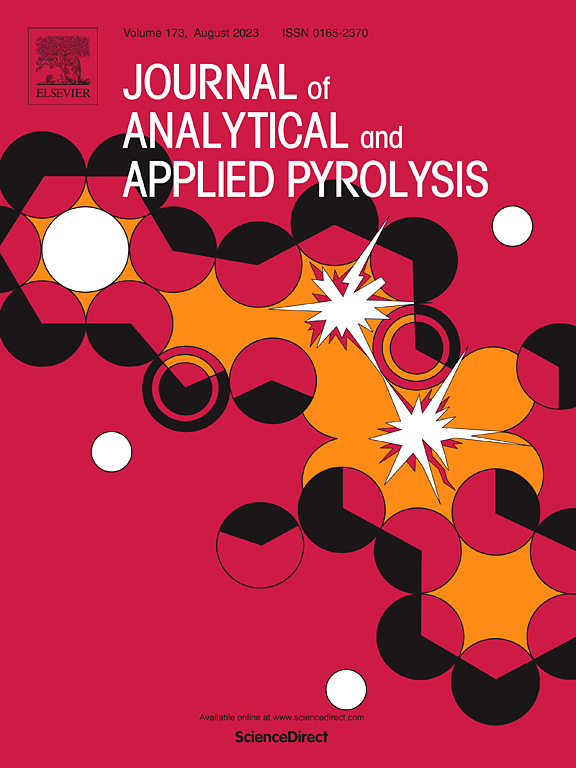废玻璃纤维增强聚合物的热化学回收:基于实验和量子化学计算的研究
IF 6.2
2区 化学
Q1 CHEMISTRY, ANALYTICAL
引用次数: 0
摘要
废旧玻璃纤维增强聚合物(gfrp)的大规模回收和资源化利用是制约复合材料工业可持续发展的关键挑战。本研究系统地研究了常见的废弃玻璃钢,特别是退役的风力涡轮机叶片(WTBs),以阐明其热化学转化机理和玻璃纤维再生技术。该方法有效解决了现有热分解方法存在的热解效率低、反应机理不明确等瓶颈。通过实验分析和密度泛函数理论(DFT)计算,本研究揭示了退役WTBs的降解特性:失重发生在290 ~ 500℃之间,平均表观活化能约为170 kJ·mol⁻¹ 。在最佳热解温度500℃,热解时间80 min,载气流量50 mL·min(⁻¹)的条件下,建立了协同热解-氧化工艺,热解效率为89.5 %。通过随后的氧化处理(500°C, 80 min),成功地获得了表面清洁的玻璃纤维,实现了超过98 %的有机成分去除效率。机理研究表明,环氧树脂热解遵循自由基主导的降解途径:C-O键的初始均裂裂解产生各种自由基中间体,这些中间体随后重新结合形成双酚a、环氧乙烷、环氧丙烷和丙烯等特征产物。值得注意的是,玻璃纤维(sio2)的存在显著降低了C-O键的顺序,从而加速了树脂基体的解离。本研究为gfrp的增值提供了理论基础和技术途径,具有巨大的工业应用潜力。本文章由计算机程序翻译,如有差异,请以英文原文为准。
Thermochemical recycling of waste glass fiber-reinforced polymers: A research based on experiments and quantum chemical calculations
The large-scale recycling and resource utilization of waste glass fiber-reinforced polymers (GFRPs) represents a critical challenge constraining the sustainable development of the composite materials industry. In this study, common waste GFRPs, specifically retired wind turbine blades (WTBs), were systematically investigated to elucidate their thermochemical conversion mechanisms and glass fiber regeneration technologies. This approach effectively resolves the existing bottlenecks of low pyrolysis efficiency and unclear reaction mechanisms in current thermal decomposition approaches. Through experimental analysis and density functional theory (DFT) calculations, this study reveals the degradation characteristics of retired WTBs: weight loss occurs between 290 and 500°C with an average apparent activation energy of approximately 170 kJ·mol⁻¹ . A synergistic pyrolysis-oxidation process was developed, achieving 89.5 % pyrolysis efficiency under optimal parameters (pyrolysis temperature: 500°C, pyrolysis time: 80 min, carrier gas flow rate: 50 mL·min⁻¹). Surface-clean glass fibers were successfully obtained via subsequent oxidative treatment (500°C for 80 min), achieving an organic component removal efficiency exceeding 98 %. Mechanistic studies demonstrate that epoxy resin pyrolysis follows a free radical-dominated degradation pathway: initial homolytic cleavage of C-O bonds generates various radical intermediates, which subsequently recombine to form characteristic products including bisphenol A, ethylene oxide, propylene oxide, and propylene. Notably, the presence of glass fibers (SiO₂) significantly reduces C-O bond orders, thereby accelerating resin matrix dissociation. This research provides both theoretical foundations and technical pathways for GFRPs valorization, demonstrating substantial industrial application potential.
求助全文
通过发布文献求助,成功后即可免费获取论文全文。
去求助
来源期刊
CiteScore
9.10
自引率
11.70%
发文量
340
审稿时长
44 days
期刊介绍:
The Journal of Analytical and Applied Pyrolysis (JAAP) is devoted to the publication of papers dealing with innovative applications of pyrolysis processes, the characterization of products related to pyrolysis reactions, and investigations of reaction mechanism. To be considered by JAAP, a manuscript should present significant progress in these topics. The novelty must be satisfactorily argued in the cover letter. A manuscript with a cover letter to the editor not addressing the novelty is likely to be rejected without review.

 求助内容:
求助内容: 应助结果提醒方式:
应助结果提醒方式:


